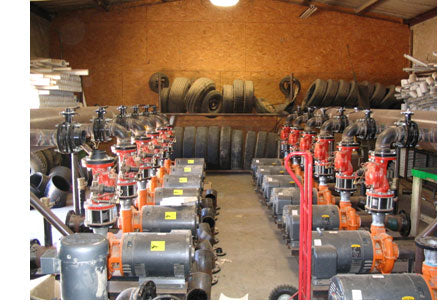Multiple Pumps
The most efficient way to pump water at variable flow rates or variable pressures is to use multiple pumps. Pumps can be installed in parallel or series. In parallel pumps can provide extra flow. In series pumps can provide extra head.

Pumps in Parallel
Pumps in parallel can increase the volume of water pumped. Additional pumps can be brought on line as more flow is needed. An increase in flow or a decrease in pressure can be used to call another pump to come on line. When multiple pumps are being used in parallel, it is important to understand how they work together. During times of high flow, when the head required is below the Best Efficiency Point or BEP of all the pumps, all the pumps are contributing as much as they can. During times of low flow, if more than one pump is running, the head of one pump could negatively effect the other. As the pumps are being worked to the left side of their curve, if one of the pumps can build more head than the other, it can cause the lowest head pump to be deadheaded. For this reason it is important to have good control over which or how many pumps are operating according to the flow and pressure. When multiple pumps are being used for low flow applications, it is important that all the pumps have identical performance curves.
It is not recommended to use a single Cycle Stop Valve or any other valve to control multiple pumps. As the CSV reduces the flow, each pump is bucking the others back pressure. As described above, if one pump can build more head than another, the lowest head pump can be deadheaded. Also when flow becomes really low, and the CSV is in the bypass position, both pumps are sharing the bypass rate. This bypass rate of the CSV is designed to adequately cool one pump. It may not be adequate to cool more than one pump. For this reason we recommend using multiple smaller valves, one for each pump, instead of one larger valve on the system. In this way, even if all the valves are set at the same pressure, each pump is only bucking it's own backpressure, and not that of the other pumps. Traditionally we would want to stagger the pressure settings of the valves, so that the smallest pump has the highest pressure setting. In this way, when the system pressure is equal to the valves set pressure, we know that this pump can handle the flow required. The other pumps can then be turned off at this pressure, with their own pressure switch. Staggering the pressure setting of the individual CSV's and pressure switches can determine which or how many pumps are needed, without requiring a flow meter.
Pumps in Series
When additional pressure or head is required, pumps can be installed in series. Each pump will then add what pressure it can, to the pressure on it's suction. If a pump can build 50 PSI, and another pump is feeding this pump 50 PSI, the output of the second pump will be 100 PSI. The pumps can be bolted together directly to achieve this outcome, or they can be miles apart. When the two or more pumps are in the same location, a single CSV and pressure switch can be used as if there was only one pump. The only concern is that the seal on the second pump, can handle the dead head pressure of the two pumps combined. This can be useful when only single-phase power is available, and more horsepower is required. Two 10 HP pumps can be used in this way to produce a 20 HP outcome, while making use of the single-phase power available.
When the pumps are a distance away from each other, each pump should have it's own CSV, pressure switch, and pressure tank. This can be useful when boosting water over many miles. An additional pump can be installed anywhere down the line it is needed. With Cycle Stop Valves controlling the pumps, the first pump will be supplying the exact amount of flow needed. Additional pumps will pick up the flow and boost it to another pump or the next location.
